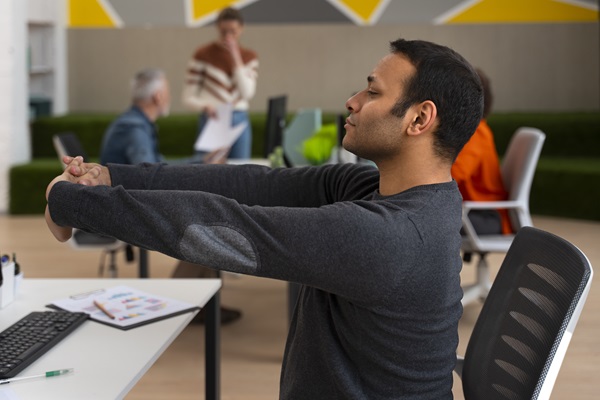The modern workplace, with its reliance on computers and technology, has revolutionized productivity but inadvertently birthed a sedentary epidemic. As we spend more hours glued to our desks, the detrimental effects of prolonged sitting on our health are becoming increasingly evident. This article explores the myriad dangers of sitting too much and provides practical strategies to infuse physical activity into our predominantly sedentary work routines.
Understanding the Risks
Sitting, once considered a benign activity, is now recognized as a significant health hazard. Recent research reveals that prolonged sitting can lead to a host of chronic health issues, transforming the very nature of our work environments into potential breeding grounds for these maladies.

The Dangers of Sitting Too Much
Increased Risk of Heart Disease
Heart disease, a leading cause of mortality worldwide, is exacerbated by sedentary behavior. Prolonged sitting is associated with elevated levels of unhealthy blood fats, an increased risk of hypertension, and reduced metabolic efficiency. These factors collectively contribute to a higher likelihood of developing heart disease.
A Correlation with Diabetes
Sitting for extended periods has been correlated with the development of type 2 diabetes. Prolonged inactivity impairs the body’s ability to regulate blood sugar levels, increasing the risk of insulin resistance, a precursor to diabetes.
The Role of Sitting in Weight Gain
Weight gain is a common consequence of sitting too much. The lack of physical activity suppresses the body’s ability to burn calories efficiently. Consequently, excess calories are stored as fat, leading to weight gain.
The Impact on Mental Health: Depression and Dementia
The dangers of sitting too much are not only detrimental to physical health but also affect mental well-being. It has been linked to an increased risk of depression and cognitive decline, including dementia. The lack of physical activity can lead to feelings of isolation and contribute to the development of mental health disorders.
The Association with Various Types of Cancer
Research suggests that the dangers of sitting too much are linked to multiple types of cancer, including colon, breast, and ovarian cancer. The exact mechanisms are still being explored, but the sedentary lifestyle appears to play a role in the development of these diseases.
The Alarming Trend of Sedentary Behavior in Children
Disturbingly, sedentary behavior isn’t exclusive to adults. A rising concern is the increasing prevalence of sedentary habits in children. The habits formed in childhood can have lifelong consequences for health.
Assessing Your Risk
Understanding the risk posed by prolonged sitting is essential. Just Stand, a charity dedicated to raising awareness about the perils of sedentary behavior, classifies individuals’ risk levels based on their daily sitting time:
- Low risk: Sitting for less than 4 hours per day.
- Medium risk: Sitting for 4–8 hours per day.
- High risk: Sitting for 8–11 hours per day.
These classifications offer a sobering reminder of the potential health consequences of a sedentary lifestyle.

Active Strategies for Deskbound Professionals
The good news is that it’s possible to counteract the dangers of sitting too much. Implementing active strategies into your workday can help mitigate the risks and improve overall health.
Incorporating Regular Standing Breaks
Breaking up prolonged sitting with standing breaks is a simple yet effective way to counteract its harmful effects. Set a timer to remind you to stand up, stretch, and walk around for a few minutes every hour.
Desk Exercises to Keep Blood Flowing
Incorporate desk exercises to stimulate blood circulation. Simple leg lifts, seated marches, and shoulder stretches can help maintain blood flow to your extremities and reduce the risk of blood clots.
Utilizing Ergonomic Office Furniture
Ergonomically designed office furniture can make a substantial difference. Adjustable chairs and desks allow you to alternate between sitting and standing, promoting better posture and reducing the strain on your back and neck.
Encouraging Walking Meetings
Replace traditional sit-down meetings with walking meetings. Combining physical activity with work discussions not only boosts creativity and engagement but also helps combat the dangers of sitting too much.
Active Commuting Options
If feasible, opt for active commuting methods such as cycling or walking to work. These activities inject physical activity into your daily routine.
Taking the Stairs Instead of the Elevator
Whenever possible, opt for the stairs over the elevator. Climbing stairs is an excellent way to engage your leg muscles and get your heart rate up.
The Benefits of Standing Desks
Standing desks have gained popularity for good reason. They encourage standing and offer an alternative to sitting for long periods.
Implementing a Daily Stretching Routine
Incorporate a daily stretching routine to reduce muscle tension and maintain flexibility. Stretching can help alleviate the physical discomfort associated with sitting.
Utilizing Fitness Apps for Reminders
Use fitness apps to receive reminders for short physical activities throughout the day. These apps can help you stay accountable for staying active.
Desk-Friendly Resistance Exercises
Resistance exercises, even with light equipment or resistance bands, can be performed discreetly at your desk. These exercises work your muscles and help maintain strength.
Creating an Active Work Environment
Fostering an active work environment is crucial in promoting healthier habits among employees.
The Role of Workplace Culture in Promoting Activity
Workplace culture plays a pivotal role in promoting physical activity. Encourage a culture that values and supports movement during the workday.
Wellness Programs and Incentives for Employees
Many companies offer wellness programs and incentives to encourage employees to lead active lives. These can include gym memberships, fitness challenges, and wellness resources.
The Importance of Ergonomic Workstations
Invest in ergonomic workstations for employees. Ergonomic chairs, standing desks, and accessories can make it easier for individuals to incorporate physical activity into their workday.
Encouraging a Culture of Walking
Encourage employees to take walking breaks, hold walking meetings, and participate in charity walks or runs together. Promoting walking as a daily habit fosters a more active workforce.

Psychological Benefits of Staying Active
Maintaining an active work routine doesn’t only benefit physical health; it also has a positive impact on mental well-being.
Improved Focus and Productivity
Staying active at work has been linked to increased focus and productivity. Short bursts of physical activity can help re-energize the mind, leading to enhanced cognitive performance.
Boosting Creativity and Problem-Solving
Physical activity sparks creativity and problem-solving skills. Engaging in physical movement can lead to new insights and innovative thinking.
Physical activity is a natural stress reliever. It reduces the production of stress hormones and stimulates the release of endorphins, leading to a more relaxed and less anxious state of mind.
Enhanced Mood and Overall Well-Being
Physical activity triggers the release of neurotransmitters associated with happiness and a sense of well-being. Regular movement at work can lead to a more positive mood and outlook.
Staying Active Beyond the Office
Maintaining an active lifestyle goes beyond the confines of the office. It’s essential to incorporate physical activity into your daily life outside of work.
Incorporating Physical Activity into Daily Routines
Incorporate physical activity into your daily routines. Walk or cycle for errands, engage in outdoor activities, and make a conscious effort to move more.
The Significance of Leisure-Time Exercise
Leisure-time exercise is equally crucial. Dedicate time for sports, fitness classes, or any physical activity you enjoy outside of work. This not only helps maintain a healthy body but also serves as a valuable mental break.
The Connection Between Sedentary Behavior and Television
One of the most common sedentary activities outside of work is watching television. The hours spent on the couch can add up quickly, leading to more extended periods of inactivity. It’s essential to be mindful of this and seek a balance between relaxation and physical activity, perhaps incorporating exercises or stretches during commercial breaks.
Promoting Healthy Habits at Home
Promoting a healthy, active lifestyle doesn’t stop at the workplace or leisure activities. It extends to your home life and sets an example for your family.
Balancing Work and Leisure Time
Striking a balance between work and leisure is crucial. Spending long hours working at a computer only to come home and continue sitting can compound the dangers of sitting too much. Allocate time for relaxation and active pursuits in your daily schedule.
Exercise as a Family Activity
Incorporate physical activities into your family life. Go for family walks, bike rides, or engage in group sports. This not only promotes a healthy lifestyle for you but also for your loved ones.
Encouraging Children to Stay Active
In an era where screens are ever-present, encouraging children to stay active is paramount. Limit screen time and promote outdoor play and extracurricular activities. Fostering a love for physical activity in childhood can set the stage for a lifelong commitment to health.
Conclusion
The dangers of sitting too much are clear and present, but the path to a healthier, more active life is equally evident. The small steps taken to counteract prolonged sitting can lead to significant health improvements. A commitment to prioritizing health in the workplace, incorporating physical activity into daily routines, and promoting active habits at home can collectively contribute to a healthier, happier, and more productive life.
Sitting too much at work and throughout the day poses significant health risks, from heart disease to cancer. This article explores the dangers of sitting too much and provides practical strategies to stay active at work for better health and well-being.




